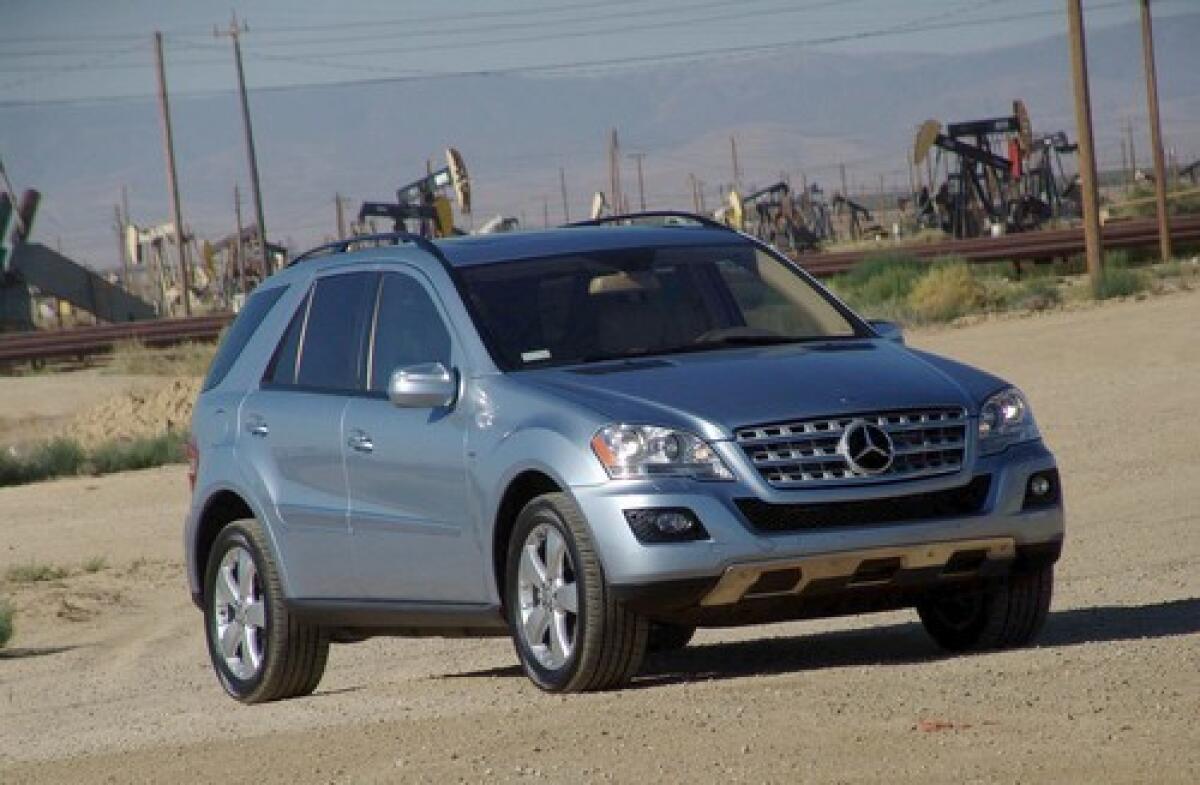Mercedes ML320 CDI: Better diesel living through chemistry

- Share via
I refuse to go down the path of juvenile humor simply because the magic ingredient in Mercedes-Benz’s new California-legal diesels, such as the ML320 CDI, is urea -- which also happens to be the magic ingredient in urine. That’s rule No. 1.
Still, I think it’s fascinating that urea -- an additive in Mercedes’ BlueTEC emissions treatment system -- serves generally the same purpose in clean diesels as it does in human engineering. Our bodies synthesize urea as a way to carry away toxic ammonia, which is a metabolic waste product (and they say gym class never pays off).
Similarly, Mercedes’ AdBlue fluid is injected into the vehicle’s exhaust, where it helps neutralize and carry away toxic nitrogen oxides (NOx), which are byproducts of high-temperature diesel combustion.
Think of the BlueTEC system as a mechanical kidney.
I had plenty of time to contemplate these mysteries after topping off the ML320 CDI with $5-a-gallon diesel in Los Angeles and heading nonstop toward Monterey. Whizzing up Interstate 5 -- oh, dear -- I was getting 24 miles to the gallon, which is downright respectable for a 4,817-pound sport utility vehicle with the aerodynamics of a catapult-fired rhino. At this rate of consumption, this oil-burner has a range of about 600 miles. Alas, I don’t have anything like that kind of range. Oh, look! The golden arches.
I truly sympathize with automotive engineers. For years, customers and the wags of wheel-dom have hammered them with the question: Why can’t we have high-efficiency diesels in the U.S. like they have in Europe? Diesel vehicles are 25% to 40% more fuel efficient than gasoline vehicles. But no conventional Euro diesel could pass California’s strict emissions tests for sulfur, particulate matter and NOx.
When a federal regulation mandating ultra-low-sulfur diesel fuel took effect in 2006, much of the problem was solved (high-sulfur fuel slowly renders diesel emissions systems ineffective). The first generation of Mercedes’ BlueTEC diesel in 2007 (in the E320 sedan) used a complex system of traps and filters to deal with particulate matter. These systems actually held particulates until engine conditions were right, then released them to be vaporized in the extreme temperatures of the exhaust. Very clever.
If any of this seems to be dreary specificity, just remember: For eco-minded gearheads, it’s sheer pornography.
The biggest hurdle left for 50-state legal diesels was NOx, hazardous, smog-forming compounds created by diesel’s super-hot compression-ignition cycle. After an extraordinary effort in Europe and Japan (Detroit? Not so much), the NOx problem has now been largely knocked.
For smaller cars such as the new diesel VW Jetta TDI and the Honda Accord diesel coming in 2009, state-of-the-art NOx traps and catalytic converters can handle the task. Bigger vehicles such as the Mercedes ML, GL and R-classes require the urea-rich AdBlue fluid to be kept on board in an 8-gallon reservoir -- a bladder, if you will. Injected into the exhaust gases, the urea solution is heat-catalyzed into ammonia, which then collects in a device called an SCR (selective catalytic reduction) catalytic converter. When the offending NOx molecules come along in the SCR, the ammonia binds to them to form harmless nitrogen. Organic chemistry was never so cool.
What does it all mean for consumers? That’s not entirely clear, for while the engineers and chemists were beavering away at the problem, the cost of diesel in the U.S. skyrocketed past gasoline. In California this week, the average per-gallon price of diesel ($4.18) is 33 cents higher than gasoline. In July it was a whopping 50 cents higher nationwide. Now that BMW, Mercedes, Audi, VW, Honda and others are making clean diesels, can consumers justify buying them?
This is precisely the dilemma that confronted early buyers of hybrids. Yes, diesel powertrains are more expensive -- the ML320 CDI is $1,000 more than the gas-engined ML350. Yes, the fuel is more expensive. Let’s say 10% more. The ML320 is only 20% more fuel-efficient (24 mpg highway vs. 20 mpg). How long will you have to own the vehicle before you begin to realize savings? It depends, really, on how and where you drive; i.e., if you log a lot of highway miles, you’ll recoup your diesel outlay sooner.
And, besides, a lot of buyers -- especially bucks-up luxury SUV buyers -- won’t really care. Many will spend the extra money knowing it’s the right thing to do (diesels clearly produce fewer carbon emissions than gas vehicles), thus favoring ecology over economy. And good for them. In a consumer society we are defined by our purchases.
Moreover, with the Mercedes M class, the choice between diesel and gas is purely a personal-value proposition because the vehicles are virtually indistinguishable. Yes, there’s a faint diesel clatter when the engine is cold, but otherwise, you can’t tell them apart. The 3.0-liter turbocharged V6 puts out 215 horsepower but a whopping 398 pound-feet of torque. Both use a seven-speed automatic transmission and 4Matic all-wheel drive (the diesel’s final gear ratio is higher to account for the diesel engine’s lower rev range). Zero to 60 times (8 seconds) are the same, as are payload and towing capacity. But for some discrete BlueTEC badging, the two vehicles are visually identical.
Maybe the only real tactile difference is the diesel M-class’ sense of deep reserves of torque, a wave that is surging, pushing, cresting, ready to spill over at a moment’s notice.
I have to pull over now.
More to Read
Inside the business of entertainment
The Wide Shot brings you news, analysis and insights on everything from streaming wars to production — and what it all means for the future.
You may occasionally receive promotional content from the Los Angeles Times.









